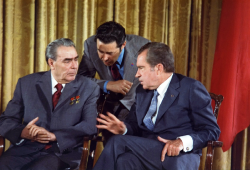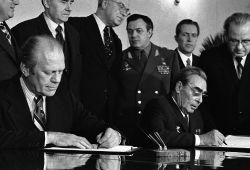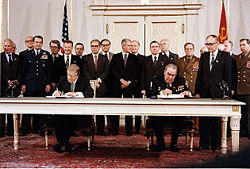Detente

D√©tente is a French term, meaning a relaxing or easing; the term has been used in international politics since the early 1970s. Generally, it may be applied to any international situation where previously hostile nations not involved in an open war de-escalate tensions through diplomacy and confidence building measures. However, it is primarily used in reference to the general reduction in the tension between the Soviet Union and the United States and a thawing of the Cold War that occurring from the late 1960s until the Soviet Invasion of Afghanistan in late December, 1979. In Russian, d√©tente was known as "razryadka" (—Ä–į–∑—Ä—Ź–ī–ļ–į).
Causes
The two sides in the Cold War, the NATO powers and the Warsaw Pact, both had pressing reasons to seek relaxation in tensions. Leonid Brezhnev and the rest of the Soviet leadership felt that the economic burden of the nuclear arms race was unsustainable. The American economy was also in financial trouble as the Vietnam War drained government finances at the same time as Lyndon Johnson's Great Society (and to a lesser extent, Richard Nixon) sought to expand the government welfare state.
In Europe, the Ostpolitik of Willy Brandt was decreasing tensions; the Soviets hoped that with Détente, more trade with Western Europe to bolster their sagging economy would be possible. Soviet thinkers also felt that a less aggressive policy could potentially detach the Western Europeans from their American ally.
Worsening relations with the People's Republic of China, leading to the Sino-Soviet Split, had caused great concern in the Soviet Union. The leadership feared the potential of a Sino-American alliance against them and believed it necessary to improve relations with the United States. Improved relations with China had already thawed the general American view of Communism.
Rough parity had been achieved in stockpiling nuclear weapons with a clear capability of mutually assured destruction (MAD). There was also the realization that the "relative gains" theory as to the predictable consequences of war might no longer be appropriate. A "sensible middle ground" was the goal.
Brezhnev and Nixon each hoped improved relations would boost their domestic popularity and secure their power.
Several anti-nuclear movements supported détente.
Summits and Treaties
The most obvious manifestation of Détente was the series of summits held between the leaders of the two superpowers and the treaties that resulted from these meetings. Earlier in the 1960s, before Détente, the Partial Test Ban Treaty had been signed in 1963.
Partial Test Ban Treaty
The Treaty Banning Nuclear Weapon Tests In The Atmosphere, In Outer Space And Under Water, often abbreviated as the Partial Test Ban Treaty (PTBT), Limited Test Ban Treaty (LTBT), or Nuclear Test Ban Treaty (NTBT) (although the latter also refers to the Comprehensive Test Ban Treaty) is a treaty prohibiting all test detonations of nuclear weapons except underground. It was developed both to slow the arms race (nuclear testing is necessary for continued nuclear weapon advancements), and to stop the excessive release of nuclear fallout into the planet's atmosphere.
It was signed by the Governments of the USSR (represented by Andrei Gromyko), the UK (represented by Douglas Home) and the USA (represented by Dean Rusk), named the "Original Parties," at Moscow on August 5, 1963 and opened for signature by other countries. There were 113 signatories. It entered into force on October 10, 1963.[1]
Later in the decade, the Nuclear Non-Proliferation Treaty and Outer Space Treaty were two of the first building blocks of Détente. However, these early treaties did little to curb the superpowers' abilities, and served primarily to limit the nuclear ambitions of third parties that could endanger both superpowers.
SALT
The most important treaties were not developed until the advent of the Nixon Administration, which came into office in 1969. The Political Consultative Committee of the Warsaw Pact sent an offer to the West, urging to hold a summit on "security and cooperation in Europe." The West agreed and talks began towards actual limits in the nuclear capabilities of the two superpowers. This ultimately led to the signing of the SALT I treaty in 1972.
SALT I
SALT I is the common name for the Strategic Arms Limitation Treaty Agreement, but also known as Strategic Arms Limitation Treaty. SALT I froze the number of strategic ballistic missile launchers at the then existing levels, and provided for the addition of new submarine-launched ballistic missile (SLBM) launchers only after the same number of older intercontinental ballistic missile (ICBM) and SLBM launchers had been dismantled.
The strategic nuclear forces niche of the Soviet Union and the United States were changing in character in 1968. The U.S.'s total number of missiles had been static since 1967 at 1054 ICBMs and 656 SLBMs, but an increasing number of missiles with multiple independently targetable reentry vehicle (MIRV) warheads had been deployed. One clause of the treaty required both countries to limit the sites protected by an anti-ballistic missile (ABM) system to one. The Soviet Union had deployed such a system around Moscow in 1966 and the United States announced an ABM program to protect twelve ICBM sites in 1967. A modified two-tier Moscow ABM system is still used, probably with missile interceptors equipped with conventional instead of nuclear warheads. The U.S. built only one ABM site to protect a Minuteman base in North Dakota where the "Safeguard Program" was deployed. Due to the system's expense and limited effectiveness, the Pentagon disbanded "Safeguard" in 1975.
Negotiations lasted from November 17, 1969 until May 1972 in a series of meetings beginning in Helsinki, with the U.S. delegation headed by Gerard C. Smith, director of the Arms Control and Disarmament Agency. Subsequent sessions alternated between Vienna and Helsinki. After a long deadlock, the first results of SALT I came in May 1971, when an agreement was reached over ABM systems. Further discussion brought the negotiations to an end on May 26, 1972 in Moscow when Richard Nixon and Leonid Brezhnev signed the Anti-Ballistic Missile Treaty and the Interim Agreement Between The United States of America and The Union of Soviet Socialist Republics on Certain Measures With Respect to the Limitation of Strategic Offensive Arms. A number of agreed statements were also made which helped to initiate the period of detente between the USA and the Soviet Union. In the same year that SALT I was signed, the Biological Weapons Convention and the Anti-Ballistic Missile Treaty were also concluded. Talks on SALT II also began in 1972.
SALT II
SALT II was a second round of talks from 1972 to 1979 between the U.S. and the Soviet Union, which sought to curtail the manufacture of strategic nuclear weapons. It was a continuation of the progress made during the SALT I talks. SALT II was the first nuclear arms treaty which assumed real reductions in strategic forces to 2250 of all categories of delivery vehicles on both sides. SALT II helped the U.S. to discourage the Soviets not to arm their third generation ICBMs of SS-17, SS-19 and SS-18 types with much more MIRVs. The USSR's missile design bureaus had developed in the late 1970s experimental versions of these missiles equipped with anywhere from 10 to 38 thermonuclear warheads each. Additionally, the Soviets secretly agreed to reduce Tu-22M production to thirty aircraft per year and not to give them an intercontinental range. It was particularly important for the US to limit Soviet efforts in the INF forces rearmament area. The SALT II Treaty banned new missile programs (a new missile defined as one with any key parameter five percent better than in currently deployed missiles), so both sides were forced to limit their new strategic missile types development although US preserved their most essential programs like Trident and cruise missiles. In return, the USSR could exclusively retain 308 of its so-called "heavy ICBM" launchers of the SS-18 type.
An agreement to limit strategic launchers was reached in Vienna on June 18, 1979, and was signed by Leonid Brezhnev and President of the United States Jimmy Carter. Six months after the signing, the Soviet Union deployed troops to Afghanistan, and in September of the same year some senators like (Henry M. Jackson) unexpectedly discovered the so-called "Soviet brigade" on Cuba. As such, the treaty was never ratified by the United States Senate. Its terms were, nonetheless, honored by both sides until 1986 when the Reagan Administration withdrew from SALT II after accusing the Soviets of violating the pact.
START
Subsequent discussions took place under the (START) and the Comprehensive Test Ban Treaty.
The Strategic Arms Limitation Treaties refers to two rounds of bilateral talks and corresponding international treaties between the Soviet Union and the United States‚ÄĒthe Cold War superpowers‚ÄĒon the issue of armament control. There were two rounds of talks and agreements: SALT I and SALT II. SALT II later became START. Negotiations started in Helsinki, Finland, in 1969 and focused on limiting the two countries' stocks of nuclear weapons. These treaties led to the START (Strategic Arms Reduction Treaty). START I (a 1991 agreement between the United States and the Soviet Union) and START II (a 1993 agreement between the United States and Russia) placed specific caps on each side's number of nuclear weapons.
Helsinki Accords
In 1975, the Conference on Security and Cooperation in Europe met and produced the Helsinki Accords, a wide ranging series of agreements on economic, political, and human rights issues. In July of the same year, the Apollo-Soyuz Test Project became the first international space mission, with three American astronauts and two Russian cosmonauts docking their spacecraft and conducting joint experiments. This mission had been preceded by five years of political negotiation and technical co-operation, including exchanges of U.S. and Russian engineers between the two countries' space centers.
Trade relations between the two blocs increased substantially during the era of detente. Most significant were the vast shipments of grain that were sent from the West to the Soviet Union each year, which helped make up for the failure of kolkhoz, Soviet collectivized agriculture.
At the same time, the Jackson-Vanik amendment, signed into law by Gerald Ford on January 3, 1975, after a unanimous vote by both houses of the United States Congress, was designed to leverage trade relations between the U.S. and the USSR, making them dependent upon improvements of human rights within the Soviet Union.
Continued Conflicts
Despite the growing amicability, heated competition continued between the two superpowers, especially in the Third World. Wars in South Asia in 1971 and the Middle East in 1973 saw the superpowers back their sides with material and diplomatic support. In Latin America the United States continued to block any leftward shift in the region with military coups. For much of the Détente period, the Vietnam War continued to rage. Neither side trusted the other fully and the potential for nuclear war remained. Each side continued to have thousands of intercontinental ballistic missiles (ICBMs) pointed at the other’s cities, SLBM submarines in the oceans of the world, hundreds of nuclear-armed aircraft deployed, and forces guarding disputed borders in Korea and Europe. The espionage war continued unabated as defectors, reconnaissance satellites, and signal interceptions were still a priority for both sides.
End of Détente
Détente began to unravel in 1979 due to a series of events. The Iranian Revolution and the subsequent hostage crisis embarrassed the United States and led much of the American public to believe their nation had lost its international power and prestige.
The Soviet invasion of Afghanistan that was launched to shore up a struggling allied regime, led to a swift denunciation by the United States and its Western allies and a boycott of the 1980 Summer Olympics, which were to be held in Moscow. American President Jimmy Carter boosted the U.S. defense budget and began financially aiding the President of Pakistan General Muhammad Zia-ul-Haq heavily, who would in turn subsidize the anti-Soviet Mujahideen fighters in the region.
The 1980 American presidential election saw Ronald Reagan elected on a platform opposed to the concessions of Détente. Negotiations on SALT II were subsequently abandoned.
Notes
- ‚ÜĎ Treaty Banning Nuclear Weapon Tests in the Atmosphere, in Outer Space and Under Water, US Department of State. Retrieved March 28, 2017.
ReferencesISBN links support NWE through referral fees
- Kissinger, Henry. Diplomacy. Simon & Schuster, 1994. ISBN 978-0671659912
- Sarotte, M. E. Dealing with the Devil: East Germany, Détente, and Ostpolitik, 1969-1973. Chapel Hill, NC: University of North Carolina Press, 2001. ISBN 0807825999
- Suri, Jeremi. Power and Protest: Global Revolution and the Rise of Detente. Cambridge, MA: Harvard University Press, 2003. ISBN 0674010310
This article contains material from the CIA World Factbook (2003 edition) which, as a US government publication, is in the public domain.
| ||||||||||||||||||||||||||||||||||||||
Credits
New World Encyclopedia writers and editors rewrote and completed the Wikipedia article in accordance with New World Encyclopedia standards. This article abides by terms of the Creative Commons CC-by-sa 3.0 License (CC-by-sa), which may be used and disseminated with proper attribution. Credit is due under the terms of this license that can reference both the New World Encyclopedia contributors and the selfless volunteer contributors of the Wikimedia Foundation. To cite this article click here for a list of acceptable citing formats.The history of earlier contributions by wikipedians is accessible to researchers here:
The history of this article since it was imported to New World Encyclopedia:
Note: Some restrictions may apply to use of individual images which are separately licensed.

